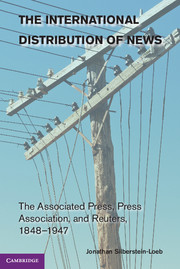 The International Distribution of News
The International Distribution of News Published online by Cambridge University Press: 05 July 2014
Between 1848 and 1947, institutional arrangements protected the supply of news. In the United States, weak regulation of telegraphy, permissive state laws, and favorable court decisions facilitated the maintenance of an exclusive form of news association that privileged those newspapers fortunate enough to be among its members. Although the AP’s exclusive organization encouraged the emergence of rivals, competition was always contrived. When the UP threatened the AP, the latter became more inclusive. To increase the number of newspapers that benefited from the fruits of cooperation, AP v. US prohibited the association from excluding newspapers from membership based on concerns about newspaper competition. After the Supreme Court forced open the AP in 1945, as the Illinois Supreme Court had done in 1900, the AP resembled a public utility. In this respect, it was similar to the British PA, which from the time of its establishment in 1868 was required by the Post Office to provide its news reports to all paying provincial newspapers.
In Britain, the Telegraph Act of 1868, and continued attempts to maintain the market structure it engendered, provided considerable protection for the provincial press until World War I. The operation of telegraphy in Britain enabled members of the PA to benefit from the comparative wealth of the London press and from the revenues of Extel and Reuters. First telephony and then the onset of war in 1914 contributed to undermining the mid-Victorian settlement brought about by the Telegraph Act. After the war, it broke down entirely. Protection for the supply of news continued but shifted from the press to radio. By 1930, the PA had largely ceased to rely on the public system of telegraphy the Post Office provided, and instead developed a private network of leased lines.
To save this book to your Kindle, first ensure no-reply@cambridge.org is added to your Approved Personal Document E-mail List under your Personal Document Settings on the Manage Your Content and Devices page of your Amazon account. Then enter the ‘name’ part of your Kindle email address below. Find out more about saving to your Kindle.
Note you can select to save to either the @free.kindle.com or @kindle.com variations. ‘@free.kindle.com’ emails are free but can only be saved to your device when it is connected to wi-fi. ‘@kindle.com’ emails can be delivered even when you are not connected to wi-fi, but note that service fees apply.
Find out more about the Kindle Personal Document Service.
To save content items to your account, please confirm that you agree to abide by our usage policies. If this is the first time you use this feature, you will be asked to authorise Cambridge Core to connect with your account. Find out more about saving content to Dropbox.
To save content items to your account, please confirm that you agree to abide by our usage policies. If this is the first time you use this feature, you will be asked to authorise Cambridge Core to connect with your account. Find out more about saving content to Google Drive.